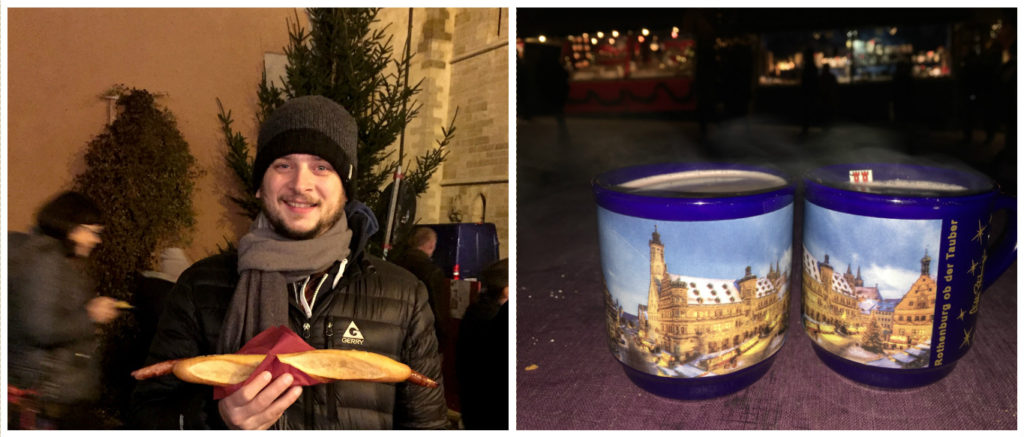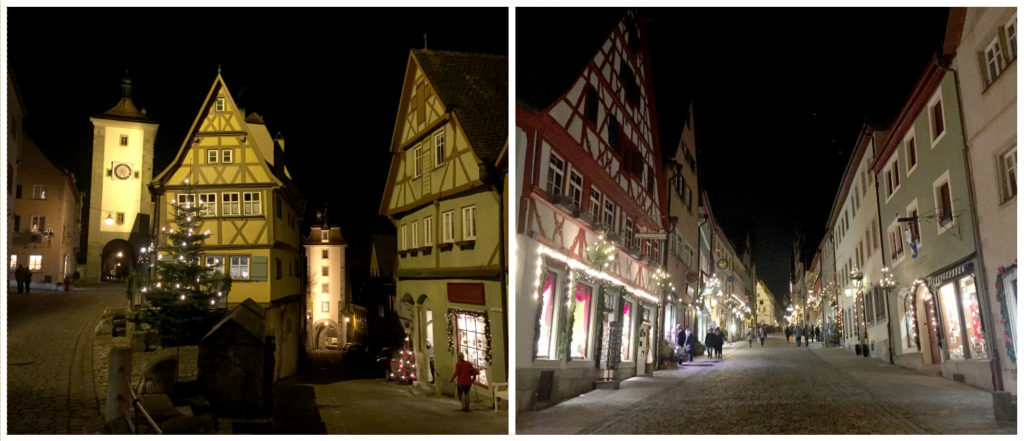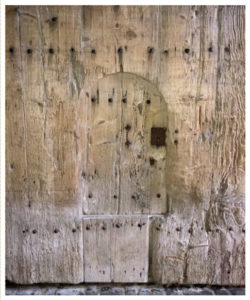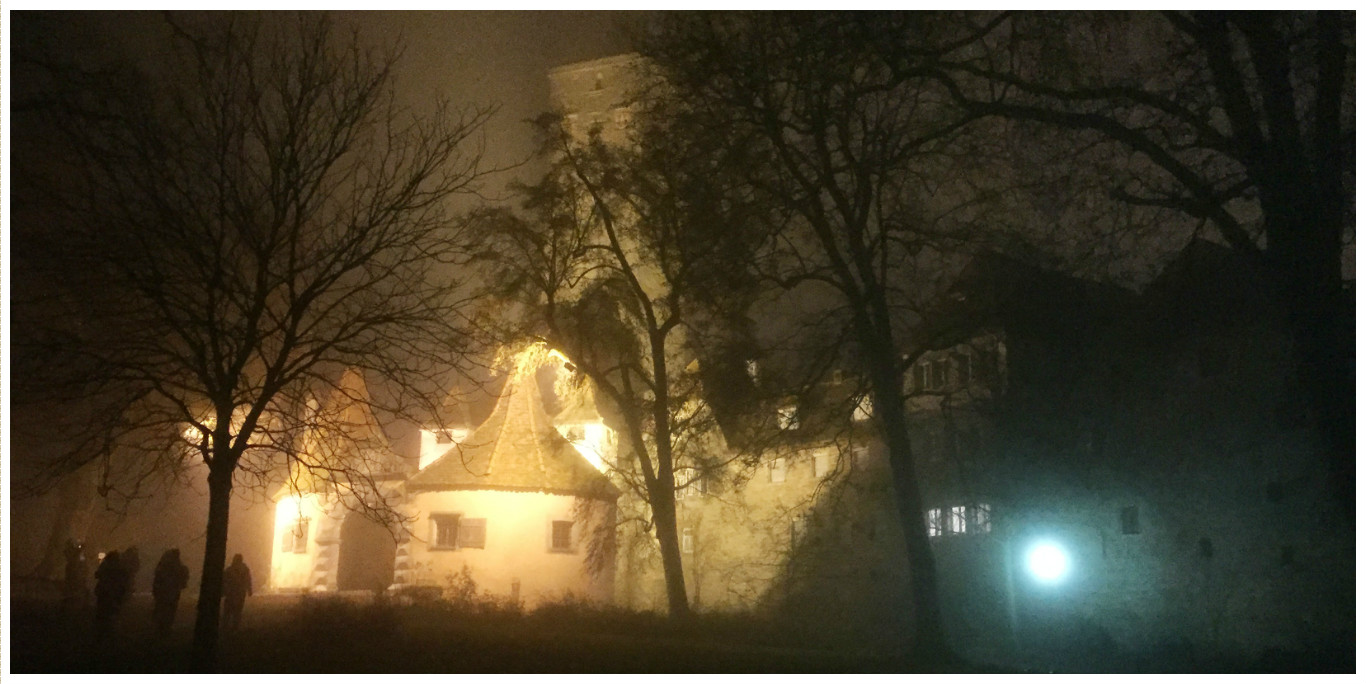I’d read that this was THE top activity to do in Rothenburg. A Watchman who has been doing this for over 25 years, took us on a nighttime walk around the city, dressed in full garb. He had a way of talking, a cadence, that sounds like a German Christopher Walken (Christopher Watchman?). But it was perfect for night time, with its sort-of-soft quality that could be comforting and still a bit eerie. Or maybe that was just the vibe from the fog on this humid and cold night.
We started in front of the town hall, and in the main market place square, where we saw the first of the famed Christmas Market. By now we’ve been inundated with Christmas markets—they’re on every other corner (in the best way!). But this one is particularly notable for its age and fame. It has been around since around 1400 and is known as one of the best Christmas Markets in all of Europe.

Perhaps it was best for us because we got glüweihn mit schoss for 3 euro each – a steal for sure! Or because we got 1/2 meter sausage in a roll. We’ll surely be back for the Christmas Market here again.
But back to the tour. We learned that the watchmen carried an axe-pole weapon of many uses, called a hellebarde, on their rounds. It was their duty first and foremost to light the lamps at night and check to make sure people locked their doors. Watchmen of this kind existed all the way through 1920.
They also carried horns with them which allowed them to sound an alarm in case there was a fire. It’s quite the bellowing sound and carries a few blocks. They’d certainly need several to form a 101 Dalmations twilight barking chain to get the message through to the whole city.
The watchman’s job was very important, yet still seen as so “low” that only two jobs were seen as even worse: executioner and grave digger. The reason for the negativity surrounding these professions is because they were all done at night—a time seen as dangerous and full of evil.
Yes, whole societies were afraid of the dark.
So our watchman walked with us around the city, describing life in the Middle Ages. He spent a good amount of time talking about the stench (video), something that we’ve all read about or been told of in history classes, but something that is utterly unimaginable in modern cities we’re used to. Animals roamed the streets defecating where they wished. While this seems like an obvious source of stench, even worse filth came from above. “Down!” was the call from a window moments before a chamber pot’s contents were strewn out to the streets, and unfortunately, to any slow-to-react passerby.
This meant of course that the rich folks escaped to their summer houses during the hottest time of the year. (heat + stink = more stink)

And rich folks there were. Rothenburg was at the crossroads of two important trade routes of the times: Prague to Paris and Scandinavia to Rome. This brought in trade galore! Not only were the people of Rothenburg able to buy a large variety of goods, they made good money exporting their grain, wine, and wool. With 6000 people, it was one of the 20th biggest cities in the Holy Roman Empire in the 16th century.
Still, our watchman tour guide reminded us that “there were no ‘good old days,'” a statement true fore more than just the city of Rothenburg. Rats were a problem in the Middle Ages. And with such frequent and established trade routes, The Plague hit Rothenburg hard. With half the population of Europe dead within 5 years, change came about. Labor wasn’t nearly as easy to find, and people demanded better wages.
 He took us to the oldest gate tower in Rothenburg’s history. It dates back to 1350 and has an interesting feature in the door: a manhole! Rothenburg is surrounded on three sides by a cliff, but since that’s not enough to deter enemies, they had this nifty wall, with a niftier contraption to help ensure no one could sneak in unnoticed. It was a tiny door on the gate that is only big enough for a single person to climb through.
He took us to the oldest gate tower in Rothenburg’s history. It dates back to 1350 and has an interesting feature in the door: a manhole! Rothenburg is surrounded on three sides by a cliff, but since that’s not enough to deter enemies, they had this nifty wall, with a niftier contraption to help ensure no one could sneak in unnoticed. It was a tiny door on the gate that is only big enough for a single person to climb through.
Back in the day, bells would ring to signal curfew, and all the farmers with their herds out at pasture would have 1 hour to return to the city. First the sheep and goats would enter, then the pigs, then the cows. I didn’t realize that this must be where the phrase “’till the cows come home” comes from. Once the animals entered the city’s gate, they would just roam home (farm animals everywhere!). If you weren’t back in time, you could still enter through the city’s one manhole, but with a fee of course. In those days, fires were one of the biggest threats to a city, and few enemies were needed to start one of those.
What makes Rothenburg so interesting to us nowadays, is how well the “medieval-ness” of this city has been preserved. The watchman described this as being the result of poverty; for a period after the Thirty Years War (Catholics v. Protestants) and the Black Plague, the town was too poor to change.
During WWII Rothenburg might have been utterly decimated if it weren’t for a defiant and brave German, and an interested American general. Rothenburg was a secondary attack point for US during the end of the war. The city was bombed, destroying 40% (I believe) and plans were set to have artillery destroy the remainder. But luckily, American General McCloy grew up with a painting of Rothenburg in his house and heard his mother’s fond memories of visiting as a tourist in the early 1910s. He didn’t want to see the picturesque city destroyed and called off the destruction by artillery. Can you believe it?
Combined with the German in charge who defied Nazi/Hitler’s order to never surrender, the Americans occupied the city, preserving it until the end of the war, just a few weeks later.
Turns out tourism can be more important than we think! It certainly helped save this city and all its well-preserved history.
For more history, check out the Watchman Tour’s website.

Lots of interesting tidbits here. The sausage looks delicious.
Thanks for reading! It was a pretty great sausage =)
Awesome tour, history, and photos! That frankfurter looks like a meal and a half; very pretty Rothenberg mugs too.
Thanks! It is certainly long but it’s only about the width of a nickel! Jon and I split it and then still ate a whole meal after (each) =)